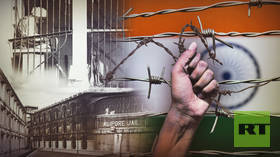Hubble captures first-ever predicted supernova blast (PHOTO)

NASA’s Hubble telescope has captured images of the first-ever predicted supernova blast, which actually happened 10 billion years ago.
Many stars end their lives as supernovas, which are blasts caused by too much mass accumulated during a star’s life, often pared by a lack of fuel to burn it. A few supernovas have so far been caught on lens, but all of them were due to sheer luck.
But on December 11, astronomers not only imaged a supernova in action, but also saw it approximately when and where they had predicted it would be.
The exploded star – dubbed Refsdal in honor of Norwegian astronomer Sjur Refsdal – was first spotted last November in the galaxy cluster MACS J1149.5+2223. Four separate images of the supernova captured at that time showed a rare arrangement known as an Einstein Cross.

After the blast, which actually took place 10 billion years ago, the light traveled in various directions around a gravitationally-warped region of space, taking about five billion years to reach us.
“While studying the supernova, we realized that the galaxy in which it exploded is already known to be a galaxy that is being lensed [distorted] by the cluster,” said Steve Rodney, study co-author from the University of South Carolina.
“The supernova’s host galaxy appears to us in at least three distinct images caused by the warping mass of the galaxy cluster,” he noted.
Warped regions were first described by Albert Einstein and appear thanks to massive galaxy clusters that bend space and time. The matter in such regions is distributed unevenly, so it sends light via various paths of different lengths.
The result is that the images of the host galaxy of the supernova are visible at different times, and scientists say that the lensed region of space would trigger more images of the supernova to emerge over the next five years.
“We used seven different models of the cluster to calculate when and where the supernova was going to appear in the future. Remarkably, all seven models predicted approximately the same time frame,” said physicist Tommaso Treu, with the University of California at Los Angeles.












